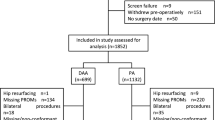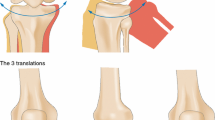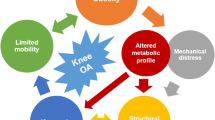Abstract
Purpose
The primary aim of this study was to define a classification in the WOMAC score after total knee arthroplasty (TKA) according to patient satisfaction. The secondary aims were to describe patient demographics for each level of satisfaction.
Methods
A retrospective cohort consisting of 2589 patients undergoing a primary TKA were identified from an established arthroplasty database. Patient demographics, Western Ontario and McMaster Universities Osteoarthritis Index (WOMAC), and short form (SF) 12 scores were collected pre-operatively and 1 year post-operatively. In addition, patient satisfaction was assessed at 1 year with four responses: very satisfied, satisfied, dissatisfied or very dissatisfied. Receiver operating characteristic (ROC) curves were used to identify values in the components and total WOMAC scores that were predictive of each level of satisfaction, which were used to define the categories of excellent, good, fair and poor.
Results
At 1 year, there were 1740 (67.5%) very satisfied, 572 (22.2%) satisfied, 190 (7.4%) dissatisfied and 76 (2.9%) very dissatisfied patients. ROC curve analysis identified excellent, good, fair and poor categories for the pain (> 78, 59–78, 44–58, < 44), function (> 72, 54–72, 41–53, < 41), stiffness (> 69, 56–69, 43–55, < 43) and total (> 75, 56–75, 43–55, < 43) WOMAC scores, respectively. Patients with lung disease, diabetes, gastric ulcer, kidney disease, liver disease, depression, back pain, with worse pre-operative functional scores (WOMAC and SF-12) and those with less of an improvement in the scores, had a significantly lower level of satisfaction.
Conclusion
This study has defined a post-operative classification of excellent, good, fair and poor for the components and total WOMAC scores after TKA. The predictors of level of satisfaction should be recognised in clinical practice and patients at risk of a lower level of satisfaction should be made aware in the pre-operative consent process.
Level of evidence
III.




Similar content being viewed by others
Change history
11 April 2018
Unfortunately, Fig. 1 in the original article contained incorrect information. Hereby, the correct figure is published and we apologise for the inconvenience.
11 April 2018
Unfortunately, Fig.?1 in the original article contained incorrect information. Hereby, the correct figure is published and we apologise for the inconvenience.
11 April 2018
Unfortunately, Fig.?1 in the original article contained incorrect information. Hereby, the correct figure is published and we apologise for the inconvenience.
11 April 2018
Unfortunately, Fig.?1 in the original article contained incorrect information. Hereby, the correct figure is published and we apologise for the inconvenience.
11 April 2018
Unfortunately, Fig.?1 in the original article contained incorrect information. Hereby, the correct figure is published and we apologise for the inconvenience.
11 April 2018
Unfortunately, Fig.��1 in the original article contained incorrect information. Hereby, the correct figure is published and we apologise for the inconvenience.
11 April 2018
Unfortunately, Fig.��1 in the original article contained incorrect information. Hereby, the correct figure is published and we apologise for the inconvenience.
11 April 2018
Unfortunately, Fig.��1 in the original article contained incorrect information. Hereby, the correct figure is published and we apologise for the inconvenience.
11 April 2018
Unfortunately, Fig.��1 in the original article contained incorrect information. Hereby, the correct figure is published and we apologise for the inconvenience.
11 April 2018
Unfortunately, Fig.��1 in the original article contained incorrect information. Hereby, the correct figure is published and we apologise for the inconvenience.
References
Alviar MJ, Olver J, Brand C, Hale T, Khan F (2011) Do patient-reported outcome measures used in assessing outcomes in rehabilitation after hip and knee arthroplasty capture issues relevant to patients? Results of a systematic review and ICF linking process. J Rehabil Med 43(5):374–381
Asif S, Choon DS (2005) Midterm results of cemented press fit condylar sigma total knee arthroplasty system. J Orthop Surg (Hong Kong) 13:280–284
Baker PN, van der Meulen JH, Lewsey J, Gregg PJ (2007) The role of pain and function in determining patient satisfaction after total knee replacement. Data from the National Joint Registry for England and Wales. J Bone Joint Surg Br 89:893–900
Bellamy N, Buchanan WW, Goldsmith CH, Campbell J, Stitt LW (1988) Validation study of WOMAC: a health status instrument for measuring clinically important patient relevant outcomes to antirheumatic drug therapy in patients with osteoarthritis of the hip or knee. J Rheumatol 15:1833–1840
Bourne RB, Chesworth BM, Davis AM, Mahomed NN, Charron KD (2010) Patient satisfaction after total knee arthroplasty: who is satisfied and who is not? Clin Orthop Relat Res 468:57–63
Brander V, Gondek S, Martin E, Stulberg SD (2007) Pain and depression influence outcome 5 years after knee replacement surgery. Clin Orthop Relat Res 464:21–26
Burch FX, Tarro JN, Greenberg JJ, Carroll WJ (2008) Evaluating the benefits of patterned stimulation in the treatment of osteoarthritis of the knee: a multi-center, randomized, single-blind, controlled study with an independent masked evaluator. Osteoarthr Cartil 16:865–872
Clement ND, MacDonald D, Burnett R (2013) Predicting patient satisfaction using the Oxford knee score: where do we draw the line? Arch Orthop Trauma Surg 133:689–694
Clement ND, MacDonald D, Simpson AH, Burnett R (2013) Total knee replacement in patients with concomitant back pain results in a worse functional outcome and a lower rate of satisfaction. Bone Joint J 95-B:1632–1639
Dawson J, Doll H, Fitzpatrick R, Jenkinson C, Carr AJ (2010) The routine use of patient reported outcome measures in healthcare settings. BMJ 340:c186. https://doi.org/10.1136/bmj.c186
Dieppe PA (1995) Recommended methodology for assessing the progression of osteoarthritis of the hip and knee joints. Osteoarthr Cartil 3:73–77
Dowsey MM, Choong PF (2013) The utility of outcome measures in total knee replacement surgery. Int J Rheumatol 2013:506–518
Driban JB, Morgan N, Price LL, Cook KF, Wang C (2015) Patient-reported outcomes measurement information system (PROMIS) instruments among individuals with symptomatic knee osteoarthritis: a cross-sectional study of floor/ceiling effects and construct validity. BMC Musculoskelet Disord 16:253. https://doi.org/10.1186/s12891-015-0715-y
Escobar A, Riddle DL (2014) Concordance between important change and acceptable symptom state following knee arthroplasty: the role of baseline scores. Osteoarthr Cartil 22:1107–1110
Farrar JT, Young JP Jr, LaMoreaux L, Werth JL, Poole RM (2001) Clinical importance of changes in chronic pain intensity measured on an 11-point numerical pain rating scale. Pain 94:149–158
Giesinger JM, Hamilton DF, Jost B, Behrend H, Giesinger K (2015) WOMAC, EQ-5D and knee society score thresholds for treatment success after total knee arthroplasty. J Arthroplasty 30:2154–2158
Gunaratne R, Pratt DN, Banda J, Fick DP, Khan RJK, Robertson BW (2017) Patient dissatisfaction following total knee arthroplasty: a systematic review of the literature. J Arthroplasty 32(12):3854–3860
Harris WH (1969) Traumatic arthritis of the hip after dislocation and acetabular fractures: treatment by mold arthroplasty. An end-result study using a new method of result evaluation. J Bone Joint Surg Am 51:737–755
Kalairajah Y, Azurza K, Hulme C, Molloy S, Drabu KJ (2005) Health outcome measures in the evaluation of total hip arthroplasties—a comparison between the Harris hip score and the Oxford hip score. J Arthroplasty 20:1037–1041
Mahomed NN, Liang MH, Cook EF, Daltroy LH, Fortin PR, Fossel AH, Katz JN (2002) The importance of patient expectations in predicting functional outcomes after total joint arthroplasty. J Rheumatol 29(6):1273–1279
Murray DW, Fitzpatrick R, Rogers K, Pandit H, Beard DJ, Carr AJ, Dawson J (2007) The use of the Oxford hip and knee scores. J Bone Joint Surg Br 89:1010–1014
Ramkumar PN, Harris JD, Noble PC (2015) Patient-reported outcome measures after total knee arthroplasty. Bone Joint Res 4(7):120–127
Robertsson O, Dunbar M, Pehrsson T, Knutson K, Lidgren L (2000) Patient satisfaction after knee arthroplasty: a report on 27,372 knees operated on between 1981 and 1995 in Sweden. Acta Orthop Scand 71:262–267
Roos EM, Roos HP, Lohmander LS, Ekdahl C, Beynnon BD (1998) Knee injury and osteoarthritis outcome score (KOOS)—development of a self-administered outcome measure. J Orthop Sports Phys Ther 28(2):88–96
Scott CEH, MacDonald D, Howie CR, Biant LC (2010) Predicting patient dissatisfaction following total knee replacement: a prospective study of 1217 cases. J Bone Joint Surg Br 92-B:1253–1258
Singh J, Sloan JA, Johanson NA (2010) Challenges with health-related quality of life assessment in arthroplasty patients: problems and solutions. J Am Acad Orthop Surg 18:72–82
Tubach F, Ravaud P, Baron G, Falissard B, Logeart I, Bellamy N, Bombardier C, Felson D, Hochberg M, van der Heijde D, Dougados M (2005) Evaluation of clinically relevant states in patient reported outcomes in knee and hip osteoarthritis: the patient acceptable symptom state. Ann Rheum Dis 64:34–37
Ware J Jr, Kosinski M, Keller SD (1996) A 12-item short-form health survey: construction of scales and preliminary tests of reliability and validity. Med Care 34:220–233
Woolacott NF, Corbett MS, Rice SJ (2012) The use and reporting of WOMAC in the assessment of the benefit of physical therapies for the pain of osteoarthritis of the knee: findings from a systematic review of clinical trials. Rheumatology 51:1440–1446
Funding
The authors received no financial support for the research, authorship, and/or publication of this article.
Author information
Authors and Affiliations
Corresponding author
Ethics declarations
Conflict of interest
The authors declare no conflict of interest with the content of this study.
Ethical approval
The data collected formed part of the study centre’s local joint registry which is registered as an ongoing service evaluation with Caldicott approval (reference number 2840). There was no additional patient contact, and as such, this project was performed as a service evaluation without the need for formal ethical approval. The project was registered with the institutions audit department (registration number 8161) and was conducted in accordance with the Declaration of Helsinki and the guidelines for good clinical practice.
Informed consent
The patients gave informed written consent to have their anonymised data collected onto the study centre’s registry and for analysis for service evaluation purposes.
Rights and permissions
About this article
Cite this article
Walker, L.C., Clement, N.D., Bardgett, M. et al. The WOMAC score can be reliably used to classify patient satisfaction after total knee arthroplasty. Knee Surg Sports Traumatol Arthrosc 26, 3333–3341 (2018). https://doi.org/10.1007/s00167-018-4879-5
Received:
Accepted:
Published:
Issue Date:
DOI: https://doi.org/10.1007/s00167-018-4879-5




